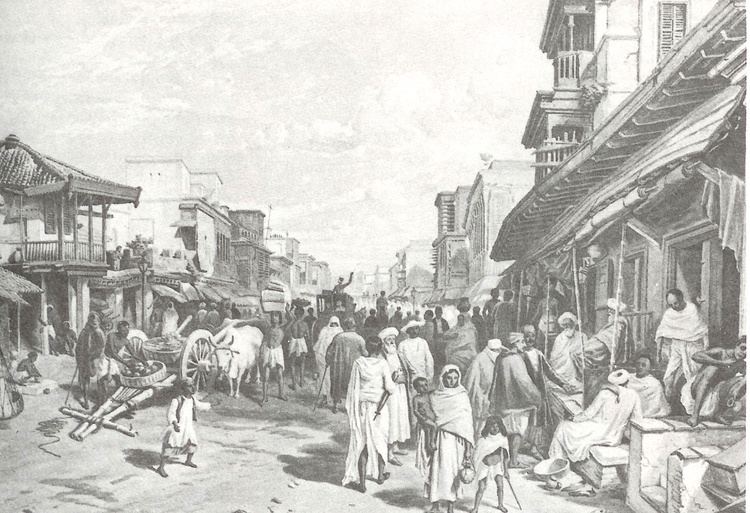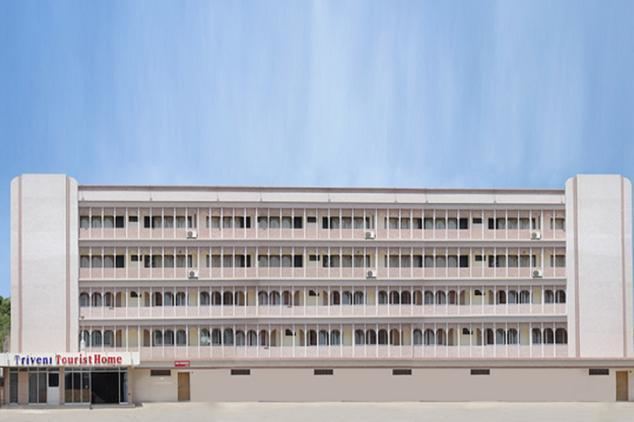Country India State West Bengal | District Hooghly | |
 | ||
Languages spoken Bengali, English | ||
Map of Tribeni
Tribeni is a small town in Hooghly in the state of West Bengal, India. It was an old holy place for the Hindus. The sanctity of the place has been recognized for many centuries and has been mentioned in Pavana-Dutam, a Sanskrit piece of the last quarter of the 12th century. The Muslims took it over during early phases of their conquest of Bengal.
Contents
- Map of Tribeni
- 1 day holiday trip tribeni hooghly wb in
- Dev hero com in tribeni bansberia hooghly
- History
- Transport Tourism
- Sports and Activities
- Scholars
- References

1 day holiday trip tribeni hooghly wb in
Dev hero com in tribeni bansberia hooghly
History

Tribeni is located at 22.99°N 88.40°E / 22.99; 88.40.
Tribeni is believed to get its name from the divergence of three rivers, Yamuna, Ganga and Saraswati. The probable earlier names were “Muktaveni”, which distinguished it from Prayag, Allahabad, known as Yuktaveni; it was spelled as “Terbonee” in James Rennell's map of Bengal in 1781. The River Saraswati surfaces from besides the famous Hindu cremate area, commonly known as ‘Shashan ghat’, towards south west into Saptagram. This leaves the river Ganges, variedly known as Hooghly or Bhagirathi to descend to the sea. The Ghat was built by a Hindu king of Orissa, Mukunda Dev which left an influence of Odisha in Tribeni visible on the temples near the ghat. The Yamuna, commonly pronounced as Jamuna in Bengali, had earlier branched off from the Ganges towards south east, but the confluence has silted up with course of time.
The town is on the western banks of the Ganges with no plateau or hills in its close vicinity and hosts one of the earliest surviving monuments of Muslim in West Bengal, Zafar Khan Gazi’s Mosque. The mosque bears an Arabic chronogram, 1298 though there remains evidence that suggests it was remodeled over time. The date is further corroborated by the fact that Tribeni along with nearby areas were occupied by Zafar Khan in 1267, after around 60 years from the conquest of Bengal. Its doorways have Hindu Vaishnavite sculptures inscribed which can be associated to the temple on which probably the mosque was built.
Existing settlements in and around Tribeni, architecture of old structures, and religious beliefs of locals gives credence to the theory that there were fewer European inhabitants in Tribeni as compared to areas around Bandel to Chandernagore. Tribeni may have been of greater importance to Portuguese & French settlements in the Hooghly District, who were presumably looking to the possibility of trade across the Saraswati River at the port of Saptagram during the 16th Century. Around 1536-37, the King of Bengal had given the Custom houses in Satgaon, today's Saptagram, along with Chittagong, the major port, to the Portuguese to set up trading centers, which ultimately extended their land occupation. During 1579 -80, Antonio Tavares founded Ugolim (Hooghly) which outshined Satgaon and it had around 5000 Portuguese inhabitants. Their settlement was highly abridged during the Mughal assault, where they appeared relatively ill-equipped for such an attack. For the same vulnerability of Mughal threats and the lack of available defense along with depleting trade prospects through Saraswati due to its drying up, Jobe Charnock, chief agent of East India Company in Hugli, along with his team decided to move more southwards to Sutanuti in 1690, where several local villages were inhabited by local merchants and a trading center was available, which later became part of Calcutta. Tribeni had also been a host to the British army during WWII in Nissen huts that can still be seen near Shibpur. Though these didn’t have much enduring impact on socio-economic state of affairs as it did in Bandel and Chandernagore, yet the town was revived by many Factories in the 20th century e.g., Jute mills, Thermal Power Station and Paper Factory for ITC as well as Tire and Rayon factories in its close vicinity.
The town thus differentiated itself from its neighbors, which were relying more on agriculture due to the available fertile land, as an industrial belt. There is no absolute evidence of an old trading center or market place, though with the advent of industries newer market places came into existence. Post independence, the town has witnessed many economic ups and downs due to the economic changes in the industries it houses. The downfall of Jute mills across the Ganges post Partition of India, which had flourished during the late 19th Century and once unseated Scotland Jute mills at Dundee, preceded the economic drain from West Bengal and the Ganges Jute Mill at Tribeni was no exception. The annual demand for Indian Jute mills of 6 million raw Jute bales during 1947-48 mostly lay unfulfilled, due to 80% of the cultivable lands for Jute falling in East Pakistan now Bangladesh, and could only meet 1.7 million bales during that period. The following three five year plans by the Government of India helped increase the production but by then the foreign demand for Indian jute started to drop, which led the jute mills to limit production, if not stop it completely. There could be few reasons attributed to such a downfall, viz., the monopolistic structure and control of the industry and methods applied to increase profitability by restricting production so as to reduce the demand and price of raw jute, the paucity of funds post independence and lack of research and development, the cheaper alternatives available and sluggish Indian market to Jute products.
The density of population, in the 21st century, is on a rise, and as such the communication has seen a growth, both in railways as well as in postal services among others; Internet, Computers and mobile phones have entered Tribeni in the late 20th century, parallel to other towns in Hooghly.
Transport & Tourism
Tribeni is 48 km from Howrah Station (Railway station adjoined to Kolkata) in Broad Gauge rail lines, which can be covered in EMU coaches (Electric Multiple Units). The Railway Station doesn’t host any express or super fast trains and usually finds them passing through it towards north Bengal and Guwahati towards north. The nearest major railway station is Bandel, 7 km on the Bandel-Katwa Railway Line, which can be used to board express trains towards north Bengal as well as towards New Delhi. The town is also benefitted by the Howrah Bardhamman Railway link, where Mogra railway station can be commuted from Tribeni at ease. There is no bus service from Kolkata; the farthest that can be travelled in a single bus towards Kolkata is Chinsurah, on Chinsurah Kalna Bus service (Rout 8). There also are bus services towards Kalyani Railway Station, situated on the other side of the Ganges, where one can reach Kolkata via Sealdah using the Sealdah Krishnanagar Broad Gauge Railways.
A 1922 built 103 ton steam engine by W.M. Breadmore Co, England had a run with five coaches from Howrah to Tribeni Railway station on 19 September 1999. This was widely known as Millennium Run and was also likely to be retained to promote tourism but was discontinued due to lack of response.
Tribeni can be travelled in tri-cycle rickshaws, commonly found in eastern India, though the cheapest available are shared autos, which might remain overcrowded and may not be practicable for carrying luggage along. The shared autos are a common sight across the town and are very often frequented by the residents to commute even 10 km on a single ride, irrespective of the concerns attached therein.
Zafar Khan Gazi’s Mosque resembles a unique transformation from stone post and lintel temples belonging to Pala senas to brick dome and arch structures, quite common to Muslims rulers in West Bengal.
Hanseswari Temple, in Bansberia, is 21 meters tall and has 13 towers, each shaped as a lotus flower, is a marvelous feat of architecture based on Kundalini and yoga concepts. Inner precincts of the minars follow the design of the human anatomy. Metallic idol of rising Sun God with his thousand bright rays has been inscribed on the top of the central minar. Even the deity has been designed and installed following the concept of Yoga and Pranayam. The Deity is blue in colour and made of wood derived from “Neem” tree.
The temple complex has another temple Ananta Basudeba temple besides the main temple, which holds a very special position as a terracotta temple with exquisite terracotta works on it.
Bandel Church, situated around 7 km from Tribeni, is the oldest church in West Bengal, initially constructed by 1599, was reconstructed post the Portuguese settlement were savaged and later awarded back by the Mughal Emperor. The statue ‘Our Lady of the Happy Voyage’ was saved from the attack and was miraculously found later and reinstated. The name of the place supposedly came from the Portuguese word ‘mast’ which was called as bandel, as the captain of a wrecked ship offered the main mast he promised to offer the first church he would find. The ship with its crew, is believed to arrive at its bank when the celebrations for the inauguration of the church were on its way.
Sports and Activities
Popular sports are Football and Cricket, which are more often played among boys. There are few tournaments that happen annually, as well as many ad-hoc tournaments are organized, mostly with altered rules from the common formats, wherein many clubs and schools compete. Other commonly played games are badminton, tipcat (‘dangulli’ in Bengali) etc., along with few board games that are also quite common: carom, chess and cards can be seen played even on road sides.
The local government usually supports other lesser popular folk team-sports e.g., kabaddi and Kho-Kho, along with the majority of schools in the town who promotes athletics.
Kite flying also takes the form of a sport (cutting down other kites on air) which can be observed more prominently in September, during the Viswakarma Puja along with the rest of West Bengal.
Scholars
Pundit Jagannath Tarka Panchanan, the legendary scholar on all branches of the Dharmasastras was born in Tribeni on 23 September 1695, had assisted Sir William Jones (philologist) in his endeavor to compile Vivadabhangarnava –that literally means ‘a break wave on the ocean of disputes' and reconcile the schools of Hindu jurisprudence, to assist judges to familiarize with the Indian culture as a consequence of a parliamentary mandate to perform judicial duties. The text was first published under the title – A Digest of Hindu Law, in 1801, which tried to legitimize the transformation of the prescriptive guidelines enshrined in the Sastras into legal rules to be directly administered through court by using terminologies like 'Digest'. He supposedly introduced Durga Puja in Tribeni, and the Baikunthupur Durga puja continues its traditions even today.
Sarat Chandra Chattopadhyay was a popular Bengali novelist and short story writer of the early 20th century, was born in Devnandapur, near Bandel.
